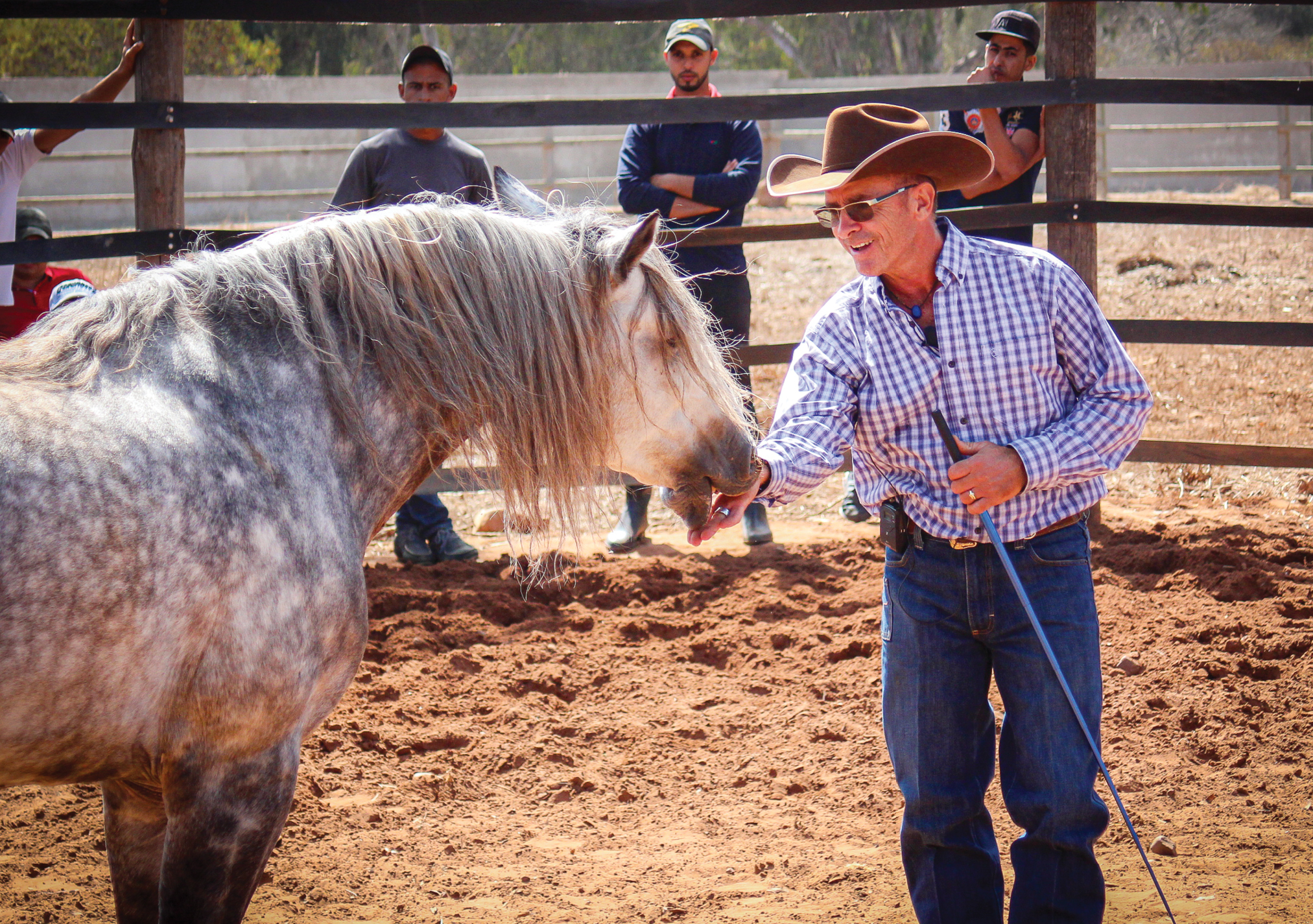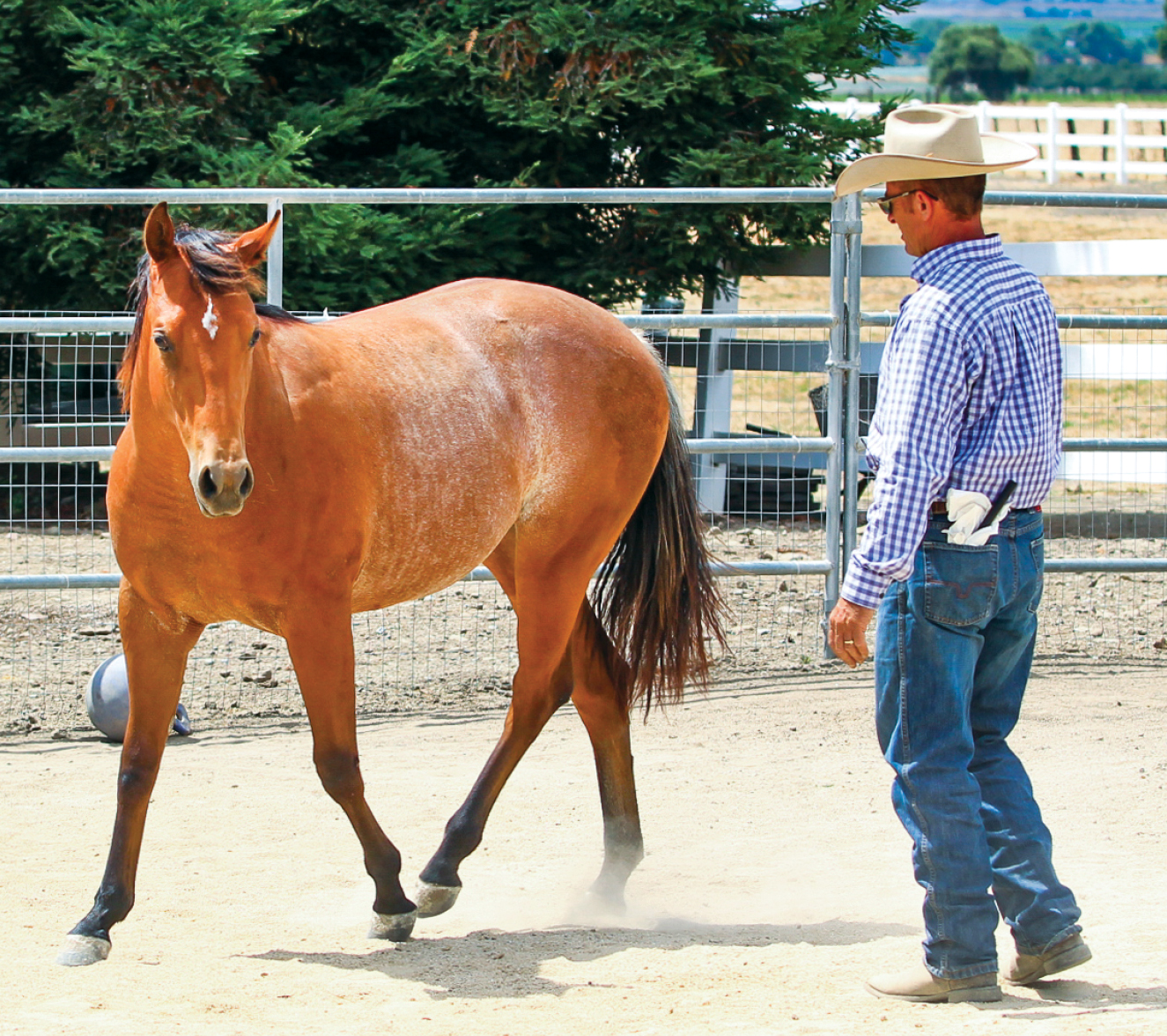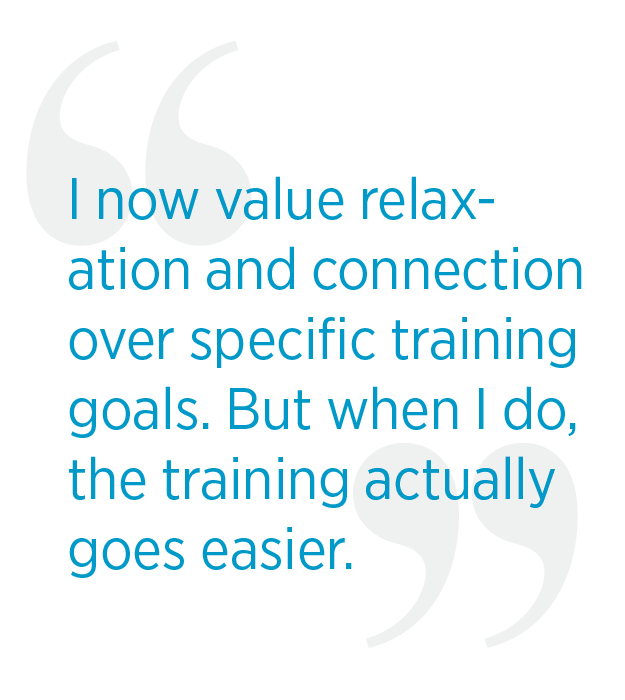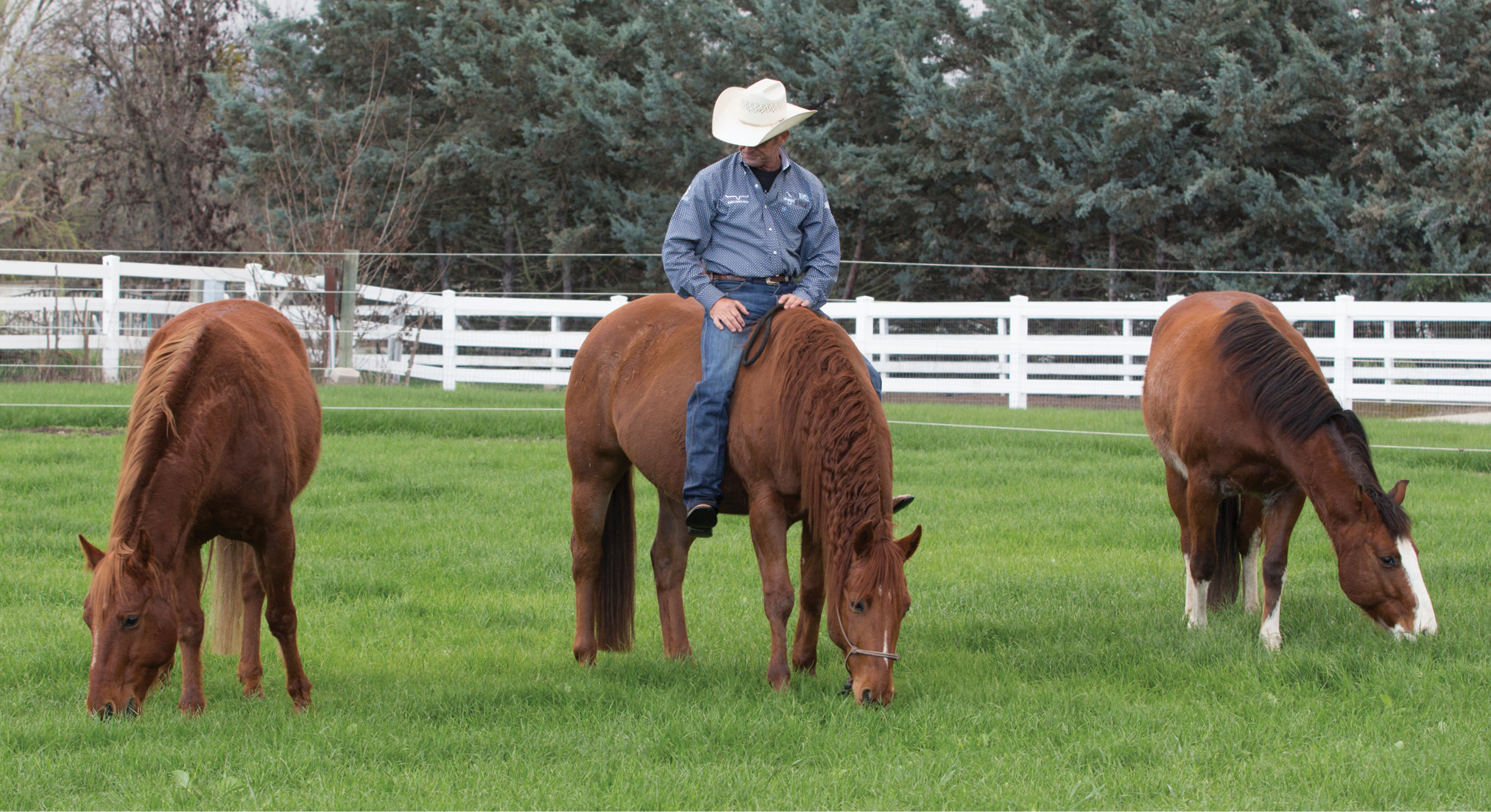Warwick Schiller has close to 200,000 followers on social media and 20 million views on YouTube. A lifelong horseman, he has traditional horse-training credentials, having represented his home country of Australia at the 2010 and 2018 World Equestrian Games plus earned a National Reining Horse Association reserve world championship, among other achievements.
[READ: JENNY MEYER’S NEW BOOK – FRIENDS WITH FOUR LEGS]
He’s also known for his ability to explain horse training in a way anyone can understand—a fact reflected by his growing fan base among riders interested in a kinder, more horse-centric method of training. His approach, which is ever-evolving, focuses on solving horse problems by changing the rider’s perspective.
Schiller’s Problem Solved column is a regular feature in the quarterly Horse&Rider and online at HorseandRider.com.
This interview reflects his most recent thinking.
[LISTEN: THE RIDE PODCAST WITH WARWICK SCHILLER]

Tyler Schiller
H&R: How would you say your perspective on horse training is different now from what it’s been in the past?
Schiller: In a word, relationship. I now value relaxation and connection over specific training goals. But when I do, the training actually goes easier. It’s a little difficult to explain, but I’ll try.
I used to train horses for the public, for performance as well as for pleasure and trail riding. And when you train for the public, you have to get the horse ready to operate for anybody. That means you have to teach the horse to filter out some things, such as the rider’s nervous energy or inadvertent physical movement.
In the reining, for example, you teach the horse to spin, then on purpose you ask him to spin while you lean off to the side, and you insist he keep going and not stop because of the leaning. So then when his owner leans, the horse will keep on spinning. So you wind up teaching the horse to ignore a lot of stuff.
And what I learned in doing that is that when you teach horses to ignore something like the rider’s nervous personality, you have to actually shut them down to a certain extent in order for that to work. But I didn’t fully realize this until I’d made a lot of changes that I hope we’re going to talk about in a minute.
In any event, these days I’m more interested in developing relationships first, and training second. And I’ve found if you can work on that relationship first, the training is actually easier.
H&R: Does it work as well for any sort of training, including for competitive events?
Schiller: Yes. I actually think it works better.
That’s because a lot of what you work on when you’re training horses is actually fixing problems you inadvertently trained into them in the first place. When you develop the relationship, you work on the horse’s thoughts first, so you avoid a lot of those errors.
For example, now I know that if a horse is dropping a shoulder or making other body-alignment errors, that means he’s physically doing something you’ve asked but his mind is somewhere else. If you can get his mind there first, it works better and you wind up doing so much less correcting.
Another example: In groundwork, I’ve spent so much time in the past trying to get the correct bend as a horse is going around me, but now I know that if his mind is on me, his body will be in the perfect shape it needs to be in.
So I’m paying a lot more attention to the small things, such as a horse’s eyes and ears, and timing my releases to when the horse’s attention goes from off me to on me, no matter what his body is doing.
Read some of Warwick’s favorite books; The Nature of Horses: Exploring Equine Evolution, Intelligence, and Behavior & The Horse Behavior Problem Solver.
Products we feature have been selected by our editorial staff. If you make a purchase using the links included, we may earn a commission. For more information click here.

Tyler Schiller
H&R: Do you have under-saddle examples for us?
Schiller: Recently a friend who trains reined cow horses had an
emergency appendectomy, so I was riding his 3-year-olds for him. They hadn’t been ridden in a few days,
and one stud was especially fresh, his ears pretty pricked. In the past, I’d have been wrestling, poking, and prodding him, and he’s too fresh and fast for that.
So with the new approach instead, whenever he looked to the left, I picked up on the right rein and just waited for his right ear to prick to the right. He didn’t even have to change direction, just move his ear and I’d let go.
After five minutes of that, he started breathing deeply, relaxing, and walking calmly. Remember, he’s a 3-year-old stud and had been as fresh as fresh can be, and the air just went out of him.
When you get them to be mentally where you are, it makes all the difference.
H&R: That’s a fascinating concept.
Schiller: You could call it meditation for horses. When humans meditate, they focus on their breathing to keep their minds in the present, rather than wandering on to other things. The goal is to remain completely in the present.
It’s similar with horses. The ancient Chinese philosopher Lao Tzu [author of the Tao Te Ching] said, “If you are depressed you are living in the past. If you are anxious you are living in the future. If you are at peace you are living in the present.”
So when a horse is braced in his body, his mind isn’t in the here-and-now. He isn’t focused on what you’re trying to get him to focus on. He’s “thinking away from you.”
And I’ve found it’s just mind boggling…how profound this is. What a difference it makes to what you’re trying to do.
So this meditation for horses as I call it—changing where their thoughts are—is one key part of it. And the other key is the relationship part, where you let the horse know you can read his mind. When you time your releases to when the horse’s attention comes to you, that seems to give them a lot of confidence. It communicates to them that you’re so perceptive that you can actually tell when they’re focused on you and when they’re not.
H&R: And why exactly does this matter?
Schiller: It’s all about connection. In my clinics, many of the participants are women. I ask them, Have you ever had a haircut and come home and you’re talking to your husband and waiting for him to notice it? Then you ask him to do something—maybe take out the garbage—and he does it cheerfully, but you’re left feeling deflated.
And you think, “He did what I asked but he never noticed my haircut!” You’re disappointed that he’s not “right there,” connected to you in that deep way that would’ve given him the clues he needed to be able to notice your hair—and a whole lot more.
Likewise, with the horse, when you release the pressure when his ear simply flicks toward you, it’s like letting him know you’ve “noticed his haircut.” You’re tuned in to him. You prove to him that you’re aware, you’re connected.
But when you don’t notice, the horse then doesn’t give you his whole self. How can I explain it? He holds stuff in reserve…he doesn’t completely open up to you.
It’s like the woman and her husband. When she realizes he’s not really connected to her at that level, there start to be little subtle things that indicate she’s not truly opening up to him in return.
I’m coming to believe that’s really a huge part of this.

H&R: Can you give us another example?
Schiller: Yes. Something I did on the ground during a clinic in Australia. It was my third day working with a 3-year-old and he wasn’t responding to work on a lead, with a flag. I couldn’t control him. So I turned him loose in the arena. He ran to the end and hung his head over the rail. I was halfway down the arena.
I started waving the flag around in a curious sort of way. Whenever his ears flicked towards me, I’d stop and turn away. I was getting flicks without asking for them, and after about 30 to 45 minutes of this, he left the gate and came and followed me around like a dog.
Eventually, I could get him to trot liberty circles around me in the arena. All this just from letting him know I was tuned in to him—I was connected to him.
And before that he’d been basically uncontrollable on a lead rope.
H&R: Reminds me of Tom Dorrance, and some others who use flags.
Schiller: And some people use even less than that! There’s Elsa Sinclair, a woman who made an indie film called Taming Wild. She gave herself a set amount of time to train a mustang with no technology at all. No equipment. No enclosures. Just herself and her voice, with the horse on 5 acres.
She calls it “freedom-based training.” The horse can leave any time he wants. You don’t ask him to do anything—it’s all volunteered.
I’d watched a lot of her stuff on video and was thinking, She’s either brilliant or she’s an idiot. Then I went to watch her in person, and within half an hour, I was like, I don’t know anything about horses. What she did was that amazing.
She was simply letting the horse know she’s aware of changes in his focus. It’s connection stuff. You don’t get the horse to connect to you…you connect to him, without wanting anything in return. And that lets him know you’re truly aware of him.
Ray Hunt always said, “They know when you know and they know when you don’t.” I used to think that meant horses know when you know what you’re doing and when you don’t. But that’s not it…it’s that they know when you are very present, and aware of them.
They can read your mind!
H&R: So their awareness means they always know whether you’re aware or not?
Schiller: Yes. What I’m starting to believe is that horses in a herd feel comfortable not because the herd provides physical protection, but because of the security of the awareness of all the other horses.
A horse thinks, I don’t have to scan 360 degrees…because the other horses’ awareness makes him feel safe. He only has to worry about one side; the other horses scan the rest.
The more you make the horse aware of how aware you are…that’s what makes him feel relaxed. If you’re present, he thinks of you as part of the herd.
And if you let a horse know you’re fully aware, it almost negates the need to train him to be relaxed. It’s a bit of a quantum shift in how we think about things.
H&R: It is. What or who has been most influential in bringing about this change in how you view training—this much more horse-centric approach?
Schiller: It’s been an evolution. Four years ago my wife bought a reining horse that was a phenomenal athlete. He just curled up like a ball in his stops. We got him cheap because he spooked at the judges’ chairs. I knew I could fix that, so I bought him sight unseen off a friend.
At that time, everything was going well in my life. I was doing clinics around the world and starting to believe my own press releases. I thought I could fix anything.
But I couldn’t do anything with him! Yes, I helped with the spooking and my wife was able to show him, but he was still very shut down. Nothing I did worked. And it woke me up. That one horse made me change how I looked at everything. He made me look outside the horse-training sphere.
I began searching outside the box I was already outside of to find ways of getting into that horse’s head. And, ultimately, he made me aware of how shut down I was! That led me to 12 months of talk therapy…and then group therapy…and I’m still doing it.

Tyler Schiller
H&R: Therapy? Please tell us about that.
Schiller: Men from my generation are taught that men don’t cry. So you’re taught to bottle that stuff up inside. But—and I learned this from author Brené Brown, who I learned about from clinician Barbra Schulte—you cannot selectively repress emotions. If you repress the extremity of one emotion, you wind up repressing all of them to some extent.
I thought, am I repressed? Could I experience more joy, more happiness?
Turns out the answers were yes,
and the ongoing talk therapy—which
I highly recommend—helped me learn how to open up. One of my group-
therapy homework assignments was to count my judgmental thoughts. We had to move a pebble from one pocket to the other every time we had such a thought. I figured I had about three negative thoughts a day, so I put three pebbles in my pocket.
Then I had 21 negative thoughts before breakfast! And the thing is, once you start counting them, you become acutely aware of how many you have—about everyone and everything, including yourself. It was the most profound thing!
The good news is, once I began letting go of the nonstop inner critiquing, I found all my relationships improving. You see, people can pick up on when you’re being judgmental in your head, even if they don’t consciously realize it. It affects how they feel about you and how they respond to you. And with horses, even more so.
When you give up being judgmental, then when you run into issues with a horse, you’re no longer thinking, This darn sonofagun. Instead, you realize he was actually just protecting himself. You learn to reframe the situation and it completely changes your energy around horses.
H&R: So clearly you’re saying this is a truly better way to train and not just a fad?
Schiller: Absolutely. It makes the training so much easier. A lot of what we do in the performance horse arena is getting rid of the brace, the stiffness. But horses aren’t stiff unless they have something to be stiff about. They can scratch their nose with a hind foot! But their resistance to us, their mental rejection of what we’re asking, is what makes them seem stiff to us.
Getting their minds first and not worrying so much about the physical stuff is the answer.
When someone now hands me the lead rope of a “bad” horse that’s been acting up and it lowers its head and heaves a sigh and walks right up to me, that tells me something. Since the therapy and the changes I’ve made, that kind of thing just happens.
It does require personal growth, and to look at things differently.
And that’s hard for all of us. But worth it.




